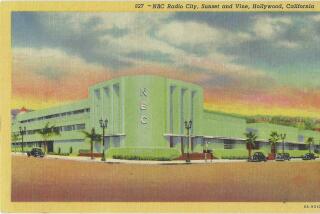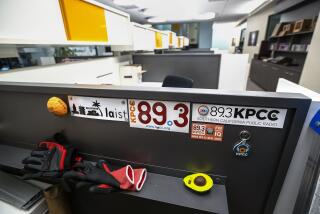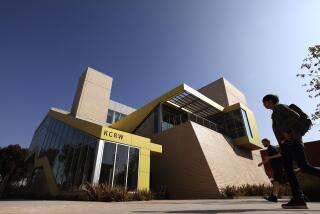KPCC-FM’s Change in Format Leads to an Uptick
- Share via
Nine months ago, KPCC-FM (89.3) dramatically changed course. Abandoning its 8-year-old format of eclectic classic American music--including jazz, swing and pop standards--the public station at Pasadena City College opted for a streamlined mix of talk and news programming by day and adult album alternative music at night.
In turn, as often happens when an entrenched audience must find another home, KPCC and the college caught flak from its core listeners, who themselves felt abandoned. But KPCC had to make the changes to boost ratings or risk losing crucial federal support this October.
The format change is paying off. Listenership is on the upswing--though still not large enough to meet the funding qualifications of the Corp. for Public Broadcasting, which is looking for proof that a station has sufficient public support to merit taxpayer dollars.
On CPB’s side, however, there’s now some movement too. The agency is unofficially adopting a less rigid standard than originally anticipated, and is inclined to give the station more time to comply.
Bob Coonrod, executive vice president and chief operating officer of the corporation, explained in an interview that CPB has “the authority to give people extra time if it looks like they’re getting close. . . . If the trend is positive, we’re not going to say to somebody you haven’t met an arbitrary deadline.”
*
Even before Coonrod indicated he was going to allow some leeway, KPCC General Manager Rod Foster noted: “I believe this format is going to work. I believe we’re going to see the kind of growth that we need to see to convince CPB to stick with us a while longer--even if we don’t hit the numbers.”
Still, KPCC--like other public stations on the low end of the Arbitron ratings lists--must keep close tabs on the company’s quarterly reports, giving the audience counts the same kind of intensive scrutiny as do commercial outlets.
Thus KPCC’s format is not necessarily here to stay. “[It’s] not forever, if it doesn’t perform,” Foster declared. “But we’re committed for about a year, at least at the outset. Until July 1. As soon as we get the Arbitrons [ratings report] in July, we’ll look at it, make a report to our licensee, and probably we’ll make a recommendation to stay with it. We also have to talk to CPB.”
Foster, who has been at KPCC’s helm nearly a dozen years, noted that the station realized early last year that it had to go in another direction. So it commissioned some research, which included input from National Public Radio.
“We knew the classic American format didn’t look like it was going to have a long-term future here,” he said. “The demographics of the audience were getting older and older every year.”
Foster contends there’s a tighter, more seamless fit now between the station’s own programming and what it was already receiving with NPR’s “All Things Considered” and Public Radio International’s “Fresh Air With Terry Gross.”
Last July, he paired a new program, Larry Marino’s “Talk of the City” (9-11 a.m.), with NPR’s call-in show “Talk of the Nation” (11 a.m.-1 p.m.), hosted by Ray Suarez, which KPCC began broadcasting live. Foster noted that the decision to emphasize talk was helped by already having a good production staff on hand from Larry Mantle’s “AirTalk.”
*
TAs for the nighttime hours, Foster said that “Triple A,” or adult album alternative, airing Mondays-Thursdays from 8 p.m. to midnight, “tested compatible with talk and was a hole in this market.” Fortuitously for KPCC, KSCA-FM (101.9) lost its album alternative format last month after it was sold and became a Spanish-language music station.
Tom Livingston, senior vice president and general manager at WETA-FM outside Washington, visited KPCC last month to report on the station for the corporation.
“The program change they made is right on the money,” Livingston said. “The audience will grow even if KPCC did nothing more than that. What they’ve done is consolidate the programming during the critical morning and midday afternoon time period, instead of shifting back and forth to music.”
Under CPB’s new guidelines, one of two factors must be met to qualify formally for the agency’s community service grant, which, in KPCC’s case, amounts to about $175,000 a year. (KPCC’s annual budget, excluding federal dollars, is $1.3 million.)
The standards, laid out early last year in response to diminishing federal dollars and pressure from conservative Republicans in Congress, say that a station in a large market like Los Angeles must show a minimum average quarter-hour listenership of 0.12% of the population reached by the broadcast signal, or must receive annual community donations averaging at least 18 cents per person.
According to CPB, that would mean for KPCC an average audience of 11,280 and local contributions of $1.8 million, based on its potential reach of 9.4 million people in Los Angeles and Orange counties and portions of Riverside, San Bernardino and Ventura counties.
KPCC hasn’t achieved either of those goals yet. It raised about $700,000 last year, for example. But Foster is encouraged, especially by the ratings.
In the latest Arbitron survey, KPCC’s average quarter-hour listenership was 8,600, a substantial jump from summer--the first three months of the new format--when the average listenership was 7,100. The previous two quarters also had been in that range.
“What we’re seeing is a straight trend upward toward the CPB numbers,” he said.
Meanwhile, KPCC has applied for a grant from CPB to help increase its visibility--and, executives hope, its listenership--with a public relations campaign.
One other local public-radio station--KCSN-FM (88.5), the classical music station at Cal State Northridge--says it will not be able to meet the CPB guidelines by October. Rene Engel, who became general manager last month, says he’s worried but also notes that it’s “unbecoming to feel alarmist.” He says he’s concentrating on raising money and assessing the station’s format.
Asked about KCSN, CPB’s Coonrod mentioned that this was the station that went through the 1994 Northridge earthquake. A mitigating factor? “Could be. Sure,” he said.
More to Read
The biggest entertainment stories
Get our big stories about Hollywood, film, television, music, arts, culture and more right in your inbox as soon as they publish.
You may occasionally receive promotional content from the Los Angeles Times.










